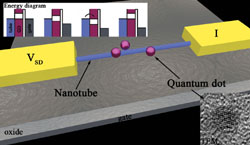Smaller technology than ever
There is so much more than meets the eye where science is concerned, particularly on the quantum scale. Miniature devices such as sensors are being built for science and technology, thanks to the use of nanomaterials. The EU-funded 'Quantum devices based on carbon nanotubes' (QDCN) project is developing an ultra-sensitive detector that probes the electrical properties of individual molecules. Such a device is being made with tiny elements called carbon nanotubes (CNTs), each approximately 1/50 000th of a human hair. To operate, these devices also require semiconductors, i.e. materials with specific electrical conductivity. A more recent and more powerful type of semiconductor on a minute scale is known as the quantum dot: it enhances conductivity and can be used to manufacture much better devices than those currently available. In order to measure electrical properties of an individual molecule, quantum dots are attached to only one electrode represented by a single CNT. The advantage of employing a CNT as an electrode causes localised screening from the electrode, rendering the study of the electronic structure of the semiconducting dots more accessible. This constitutes a new, more efficient approach developed by the project to create sensors and detectors. The novel nanodevice layout greatly simplifies the fabrication process compared to standard devices which used to use two electrodes separated by a gap of a few nanometres. This is significant, as the fabrication of such devices is quite challenging and time-consuming, and involves numerous processes and intricate equipment. The project's next step was to characterise these fabricated nanodevices and measure their accuracy. This was achieved using a new technique called 'electron counting spectroscopy' that involves measurement at low temperatures. The technique allows researchers to probe the electronic properties of semiconducting quantum dots. Importantly, it also allows them to fill or empty any semiconducting quantum dot with many electrons, a previously onerous task. In addition to creating the detector device, the project mastered various nanodevice fabrication techniques that involve many processes and much equipment to deal with at the quantum scale. These include suspended nanotube devices, graphene devices, four terminal gold nanotube devices and catalytic nanomotor devices. Moreover, the project's advances allow manipulation of Fermi energy (i.e. energy at absolute zero temperature) by significant amounts. This holds promise for nanoscale or molecular electronics, since the large energy manipulation and 'separation' in such applications is limited. Overall, QDCN has shown that single-electron detection with a CNT transistor represents a new strategy to study the separation in energy between the electronic discrete levels of the semiconducting quantum dot. In particular, it has shown that electronic levels of a quantum dot can exhibit chaotic behaviour, a phenomenon which had only been examined in theory in recent decades.







